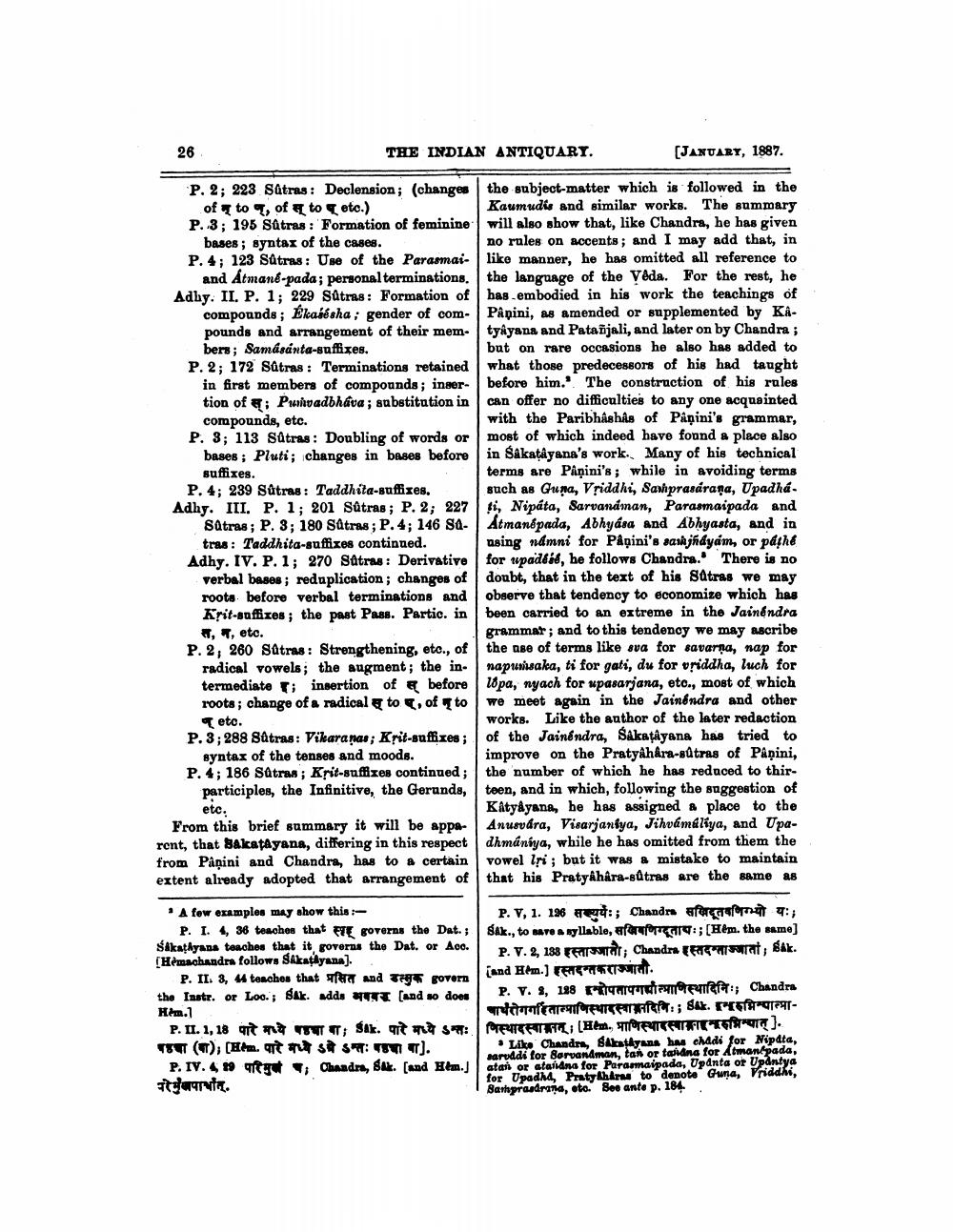________________
26
THE INDIAN ANTIQUARI.
(JANUARY, 1887.
P. 2; 223 Satras: Declension; (changes the subject matter which is followed in the of to T, of Ęto (etc.)
Kaumudis and similar works. The summary P. 3; 195 Sutras : Formation of feminine will also show that, like Chandra, he has given bases; syntax of the cases.
no rules on accents; and I may add that, in P. 4; 123 Sutras: Use of the Parasmai.like manner, he has omitted all reference to
and Atmané-pada; personal terminations, the language of the Veda. For the rest, he Adhy. II. P. 1; 229 Satras: Formation of has embodied in his work the teachings of
compounds; Ekabésha ; gender of com- Papini, as amended or supplemented by KApounds and arrangement of their mem- tyâyana and Patañjali, and later on by Chandra ; bers; Samásánta-suffixes.
but on rare occasions he also has added to P. 2; 172 Sätras: Terminations retained what those predecessors of his had taught
in first members of compounds; inger- before him.' The construction of his rules tion of Ę; Privadbháva ; substitution in can offer no difficulties to any one acquainted compounds, etc.
with the Paribhashậs of Påņini's grammar, P. 3; 113 Sutras : Doubling of words or most of which indeed have found a place also
bases; Pluti; changes in bases before in Sakatayana's work. Many of his technical suffixes.
terms are Paņini's; while in avoiding terms P. 4; 239 Sūtras: Taddhita-suffixes. such as Guna, Vriddhi, Saviprasarana, Upadhá. Adhy. III. P. 1; 201 Sūtras; P. 2; 227 ti, Nipáta, Sarvandman, Parasmaipada and
Stras ; P. 3; 180 Sätras ; P. 4; 146 St- Atmanêpada, Abhyasa and Abhyasta, and in
tras: Taddhita-suffixes continued. asing ndmni for Pågini's saskjdyám, or pághe Adhy. IV. P. 1; 270 Satras: Derivative for upadlós, he follows Chandra. There is no
verbal bases ; reduplication; changes of doubt, that in the text of his Satras we may roots before verbal terminations and observe that tendency to economize which has Krit-suffixes; the past Pass. Partic. in been carried to an extreme in the Jainandra , T, etc.
grammar; and to this tendency we may ascribe P. 2, 260 Satras : Strengthening, etc., of the age of terms like sva for savarna, nap for
radical vowels; the augment; the in- napuusaka, ti for gati, du for vriddha, luch for termediate ti insertion of x before 18pa, nyach for wpasarjana, etc., most of which roots; change of a radical & to , of įtowe meet again in the Jainéndra and other eto.
works. Like the author of the later redaction P. 3; 288 Sätras: Vikaranas; Krit-suffixes; of the Jainandra, Sakatayana has tried to syntax of the tenses and moods.
improve on the Pratyahára-sutras of Papini, P. 4; 186 Satras ; Ksit-suffixes continued ; the number of which he has reduced to thir
participles, the Infinitive, the Gerunds, teen, and in which, following the suggestion of etc.
KAtydyana, he has assigned a place to the From this brief summary it will be appe- Anusvára, Visarjaniya, Jihvamaliya, and Uparent, that Bakatayans, differing in this respect dhmániya, while he has omitted from them the from Paņini and Chandra, has to a certain vowel lsi ; but it was a mistake to maintain extent already adopted that arrangement of that his Pratyahara-sútras are the same as
A few examples may show this :
P. V, 1. 196 :; Chandrs for reform a ; P. I. 4, 38 teaches that FTE governs the Dat. ; | SAk., to save syllable, affor ;(Hem. the same] ŚAkathyana touches that it governs the Dat. or Acc. [Hemachandra follows SAkatyana).
P. V.2, 188 F t ; Chandra CFT , BAR. P. II. 3, 4 teaches that for and the govern
(and Hem.) (F177 . the Instr. or Loo; Bak. adds 2 (and so does
| P. V. 2, 128
Eurfari Chandra Hem.1
चारोगहितान्पाणिस्थादस्वादिनिः इनकमिन्यात्माP. II. 1, 18 9 e T; Suk. o masa: PE (Hem. TPOTET FICT I T). T(); (Hém.ar tu sa ST 9 ). • Like Chandr, Salat yang has chdi for Nipdta,
saruddi for Sorvandman, tas or tandna for Atman pada, P. IV. 4 19
Chandr, SN. (and Him.
j atan or atanana for Para maipada, Upanta of Upanty. परेमुंखपार्धात.
for Upadhd, Praty harus to denoto Guna, Vriddhi, Sashpraedruna, oto. Ses ante p. 184.




